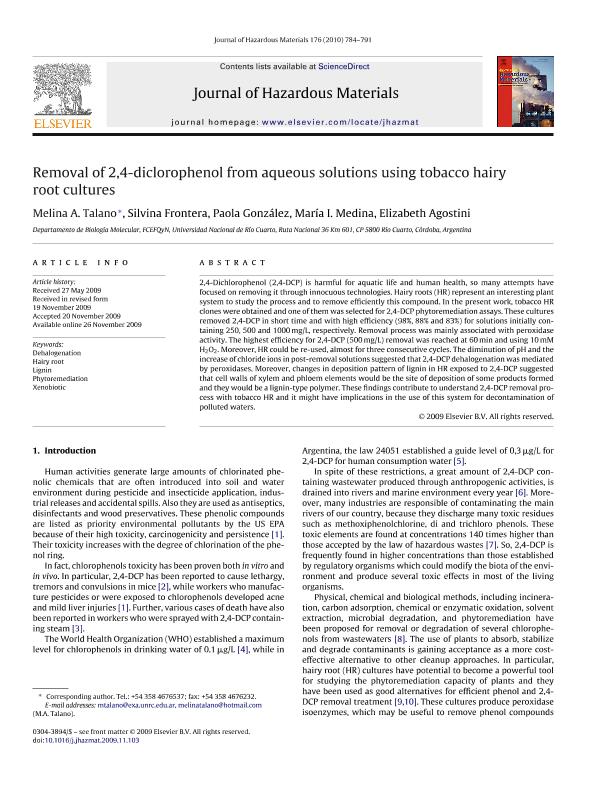Artículo
Removal of 2,4-diclorophenol from aqueous solutions using tobacco hairy root cultures
Talano, Melina Andrea ; Frontera Perez, Silvina de Lourdes; González, Paola Solange
; Frontera Perez, Silvina de Lourdes; González, Paola Solange ; Medina, María I.; Agostini, Elizabeth
; Medina, María I.; Agostini, Elizabeth
 ; Frontera Perez, Silvina de Lourdes; González, Paola Solange
; Frontera Perez, Silvina de Lourdes; González, Paola Solange ; Medina, María I.; Agostini, Elizabeth
; Medina, María I.; Agostini, Elizabeth
Fecha de publicación:
04/2010
Editorial:
Elsevier Science
Revista:
Journal of Hazardous Materials
ISSN:
0304-3894
Idioma:
Inglés
Tipo de recurso:
Artículo publicado
Clasificación temática:
Resumen
2,4-Dichlorophenol (2,4-DCP) is harmful for aquatic life and human health, so many attempts have focused on removing it through innocuous technologies. Hairy roots (HR) represent an interesting plant system to study the process and to remove efficiently this compound. In the present work, tobacco HR clones were obtained and one of them was selected for 2,4-DCP phytoremediation assays. These cultures removed 2,4-DCP in short time and with high efficiency (98%, 88% and 83%) for solutions initially containing 250, 500 and 1000 mg/L, respectively. Removal process was mainly associated with peroxidase activity. The highest efficiency for 2,4-DCP (500 mg/L) removal was reached at 60 min and using 10mM H2O2. Moreover, HR could be re-used, almost for three consecutive cycles. The diminution of pH and the increase of chloride ions in post-removal solutions suggested that 2,4-DCP dehalogenation was mediated by peroxidases. Moreover, changes in deposition pattern of lignin in HR exposed to 2,4-DCP suggested that cell walls of xylem and phloem elements would be the site of deposition of some products formed and they would be a lignin-type polymer. These findings contribute to understand 2,4-DCP removal process with tobacco HR and it might have implications in the use of this system for decontamination of polluted waters. increase of chloride ions in post-removal solutions suggested that 2,4-DCP dehalogenation was mediated by peroxidases. Moreover, changes in deposition pattern of lignin in HR exposed to 2,4-DCP suggested that cell walls of xylem and phloem elements would be the site of deposition of some products formed and they would be a lignin-type polymer. These findings contribute to understand 2,4-DCP removal process with tobacco HR and it might have implications in the use of this system for decontamination of polluted waters. 2O2. Moreover, HR could be re-used, almost for three consecutive cycles. The diminution of pH and the increase of chloride ions in post-removal solutions suggested that 2,4-DCP dehalogenation was mediated by peroxidases. Moreover, changes in deposition pattern of lignin in HR exposed to 2,4-DCP suggested that cell walls of xylem and phloem elements would be the site of deposition of some products formed and they would be a lignin-type polymer. These findings contribute to understand 2,4-DCP removal process with tobacco HR and it might have implications in the use of this system for decontamination of polluted waters.
Palabras clave:
DESHALOGENATION
,
HAIRY ROOT
,
LIGNIN
,
PHYTOREMEDIATION
Archivos asociados
Licencia
Identificadores
Colecciones
Articulos(CCT - CORDOBA)
Articulos de CTRO.CIENTIFICO TECNOL.CONICET - CORDOBA
Articulos de CTRO.CIENTIFICO TECNOL.CONICET - CORDOBA
Citación
Talano, Melina Andrea; Frontera Perez, Silvina de Lourdes; González, Paola Solange; Medina, María I.; Agostini, Elizabeth; Removal of 2,4-diclorophenol from aqueous solutions using tobacco hairy root cultures; Elsevier Science; Journal of Hazardous Materials; 176; 1-3; 4-2010; 784-791
Compartir
Altmétricas



